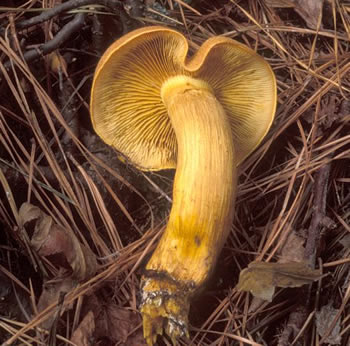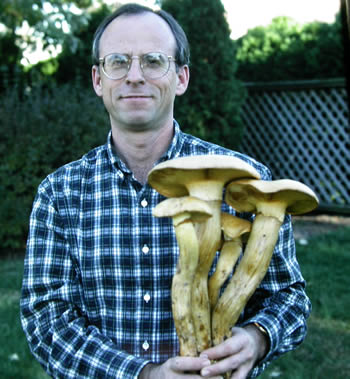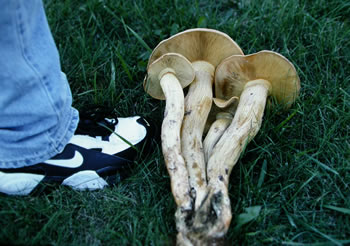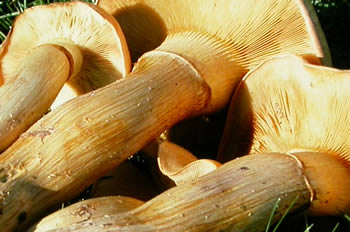Gymnopilus spp.
Scientific names: Gymnopilus ventricosus (Earle)
Hesler; Gymnopilus picreus (Pers.) P. Karst.,
Gymnopilus junonius (Fr.) P.D. Orton (= G. spectabilis
(Weinm.) A. H. Smith); G. fulvosquamulosus Hesler; G.
penetrans (Fr.) Murrill
Derivation of names: Gymnopilus means "naked pileus"
which is not descriptive of the entire genus because a
pileus is the cap of the mushroom and some Gymnopilus
species have caps with scales.
Order: Agaricales
Family: Hymenogastraceae
Occurrence on wood substrate: Saprobic;
single to
scattered or clustered on hardwoods and conifers.
Dimensions: Consult field guides.
Cap: Consult field guides.
Gills: Attached.
Spore print: Orange to rusty-orange to bright rusty
brown.
Stipe: Consult field guides.
Veil: A partial veil is often present.
Edibility: Many species are bitter, some are
hallucinogenic, and the edibility of the majority is unknown.
Comments: There are many species and little consensus
on identifying them. Macroscopically, they can be
confused with Pholiota species and with the deadly
Galerina marginata complex. Microscopically, spores of
Gymnopilus species are finely roughened (warty) whereas
Pholiota species have smooth spores. Species
identifications by the contributing
photographers were
accepted as is but note my comments for pictures labeled
G. spectabilis.
More information at MushroomExpert.com:

Figure 1. G. ventricosus. Photo © Rick Van de Poll.

Figure 2. G. fulvosquamulosus.
Photo © John Plischke III.

Figure 3. G. penetrans. Photo © John Plischke III.

Figure 4. G. picreus. Photo © Rick Van de Poll.

Figure 5. G. spectabilis. Photo © Larry Grand.
Note: Recent DNA studies indicate that G. spectabilis
(also called G. junonius) is a misapplied name
because
G. junoniusis (=G. spectabilis) does not occur in North
America. It is uncertain, then, which North
American
species
name applies to the specimen photographed
above.

Figure 6. G. spectabilis. Photo © Dianna Smith.
Note: See comments for
G. spectabilis for Fig. 5.

Figure 7. G. spectabilis. Photo © Pam Kaminski.
Note: See above comments for
G. spectabilis.

Figure 8. Many years ago I found this cluster arising
from the hollowed center of a large rotting stump near
my home in central Pennsylvania. I never saw such a
large mushroom.
Unfortunately, at that time, I didn't
know that much about mushrooms. No spore print was
obtained and
the
mushroom was discarded. Based on its
macroscopic
features, I believe it is a species of
Gymnopilus but I have no firm evidence.
Photo © Gary
Emberger.

Figure 9. Same mushrooms as in Figure 8. The
mushrooms grew as a cespitose cluster.
Photo © Gary
Emberger.

Figure 10. Same specimens as in Figures 8 and 9. The
gills are attached and there is a persistent ring high on
the stalk.
Photo © Gary
Emberger.